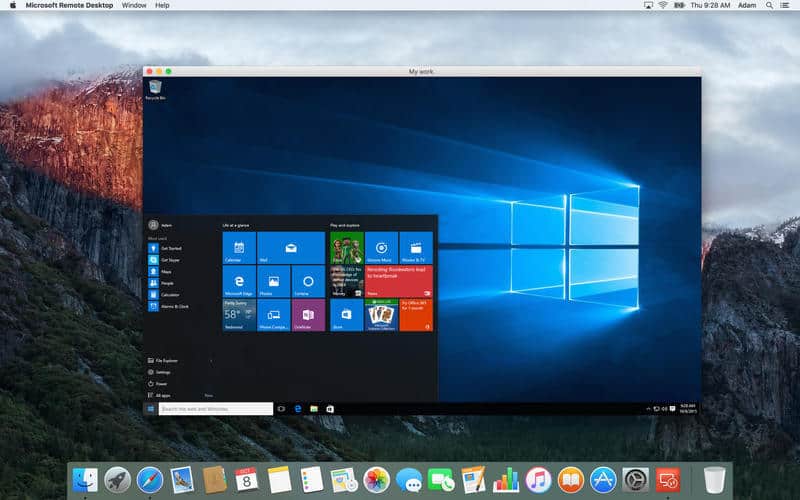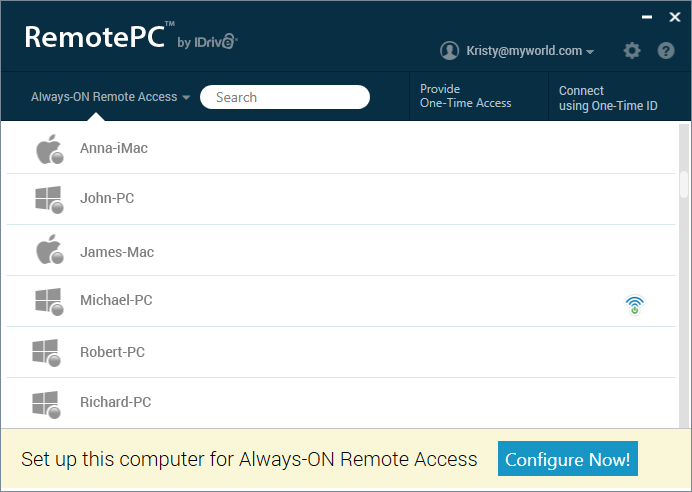Remote Desktop Access Guide For Mac
Friday, April 21st, 2017 Author: Update: Have you ever been away from your home or office and suddenly realized that you a) left it on when you meant to shut it down, b) tried to run a report or access a system only available from that machine, or c) want to grab a file that you haven’t yet moved to the cloud? Today we’ll take a look at three ways to remotely access a Mac, something that can save you from making an unnecessary trip as we near. Back to My Mac Back to My Mac is a feature of iCloud that lets you access a network of Mac computers — or just one — from another Mac. If you just need files or folders from the remote Mac, you can drag them to your local Mac.
Need to control that remote Mac as if you were sitting right in front of it? Back to My Mac gives you a way to use your local and or to launch apps and edit documents on the remote machine. The best thing about Back to My Mac?
Anesthesia know when to use modifiers g8 and g9 for macros. There have been no changes to Medicare policy and guidelines regarding documentation and reimbursement for these services.
There’s no price tag on this solution — it’s part of iCloud and macOS. You’ll just need two or more Macs using the same iCloud account (OS X Lion 10.7.5 or later), an AirPort base station or another Wi-Fi router that supports UPnP or NAT-PMP, AirPort Utility 6.3 or later, a fairly fast Internet connection, and a firewall that allows remote connections. For those who work in offices, be sure to ask permission to use Back to My Mac and check with your network administrator to find out if the firewall will support Back to My Mac connections. Here’s how to set up Back to My Mac on the Mac(s) you wish to access: 1) Launch System Preferences, then click iCloud 2) Sign into iCloud if you haven’t already done so 3) Select Back to My Mac from the list of iCloud services (see image below). The Back to My Mac service is highlighted. Check the box to enable it.
4) You may be asked to follow some setup instructions. If so, be sure to follow those instructions precisely. 5) Apple has that are good to follow when setting up Back to My Mac.
6) Note that you can also set up an AirPort base station with an attached or a Time Capsule for remote access using Back to My Mac. To do this from a Mac on the same network as the AirPort base station, launch AirPort Utility (in the Utilities folder inside the Applications folder), select the AirPort or Time Capsule, and then click Edit. Log into the base station with your base station password ( not your iCloud or Mac password), then select the Base Station tab. In the Back to My Mac section, click the + (plus sign) button, then enter the Apple ID and password you’ll use with Back to My Mac. When a green status indicator appears, Back to My Mac is turned on. Click Update to save your changes on the base station. Now, from your Mac, gaining access to the remote Mac or AirPort base station is a snap.
1) From the Finder menu, choose Preferences, then click the Sidebar tab 2) In the Shared section, make sure that Back to My Mac is checked. (A Back to My Mac control screen, showing the shared screen controls at top) As you can see from the image above, a set of control buttons is available in the pane directly above the shared screen. Clicking the Control button allows full control of the device, or you can simply view the remote screen by clicking the “binoculars” button. The next set of buttons shows the remote Mac desktop in its full size (left button) or scaled to fit the window on your local Mac. Finally, the Clipboard button provides a way to get or send data from or to a clipboard that is shared between the remote and local Macs. When your Back to My Mac session is complete, simply close the window for the remote Mac by clicking the “red dot” (close button) in the upper left corner of the window. Apple Remote Desktop Back to My Mac is perfect for situations where you may have one or two Macs that you need to remotely access or control.
For system administrators or support personnel, you may have dozens or hundreds of Macs that you could theoretically need access to. Apple has had an application called for many years that is useful for support. Available in the for $79.99, Apple Remote Desktop has sadly been somewhat ignored in recent years and currently has a very low rating in the store’s reviews. Once set up, Apple Remote Desktop not only provides a way for support personnel to control remote Macs with a simple double-click of the computer name on a list of all available Macs, but also has features for creating inventories of those machines, performing remote updates and upgrades, and so on. (Apple Remote Desktop, with a shared desktop in the foreground) The screenshot above shows that Apple Remote Desktop uses a very similar interface to Back to My Mac when remotely accessing or controlling a Mac, although the way that the sharing sessions are started is quite different. Parallels Access The third method I’ll discuss today is Parallels Access, applications and service provided by the same company that makes the virtual machine environment. The best thing about Parallels Access is that once the client application is installed on the remote Mac, it can be accessed from just about any computer — and that means any device with a web browser or any iPhone, iPad or Android device.
Accessing a remote 27-inch 5K Retina iMac from a web browser using Parallels Access A can be purchased for as little as $19.99 per year, which allows one user to connect to up to 5 computers from any number of mobile devices, and there are plans for businesses as well. Note that there are a variety of other solutions available for accessing or controlling remote Macs.

A search for VNC (Virtual Node Controller) on the Mac App Store shows a variety of applications that can be used. I’ve chosen these three methods as they provide a cross-section of the remote access and control solutions that are available. Back to My Mac is free and very useful for those who may have a desktop Mac at one location and would like to use a MacBook to access it. Apple Remote Desktop is targeted towards those who are system administrators or support personnel, although the application seems to have been abandoned by Apple. Parallels Access is very useful from almost any type of mobile device or even just a web browser.
If there’s a remote access and control solution that you prefer, please let other readers of the Rocket Yard know about it in the comments section below. Recent Posts. Macs last a long time. Don't plunk down your hard earned money on a new Mac when an upgraded Mac can run faster than a new Mac. We have the best upgrades and support for Macs: The easiest and most cost effective way to get the most from your Mac. Open and create more at one time with less slowdowns. SSDs are up the 91 times faster than a hard drive.
Remote Desktop Access Guide For Mac Address
Unleash the true potential of you Mac by upgrading to an OWC SSD. OWC Install Videos guide you step-by-step so you can experience the blazing performance difference an OWC SSD offers. Easily expand your storage with durable external drives from OWC. From bus-powered portables to massive capacity desktop models, our external drives are time-tested and industry trusted to provide you great reliable storage whatever your needs may be. Who says the optical drive is dead? Optical storage offers a great way to archive data long term, and Blu-ray media offers a tremendous amount of storage in a single disc.

Remote Desktop Access Guide For Macbook
Watch Blu-ray movies to experience near studio master image quality. Our award-winning U.S. Based customer service is at the ready to help you with any upgrade questions you may have. We're available online and on the phone 24/7. Say hello today and find out what your Mac can do.